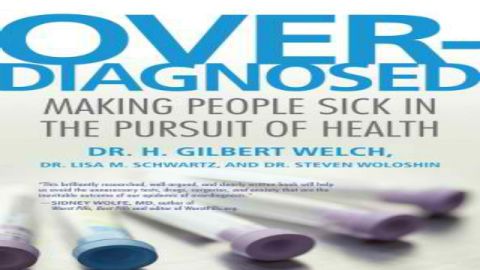Overdiagnosis. The Danger of Calling People Sick, Who Aren’t

If a doctor looked at you or me thoroughly enough, with all the diagnostic tools now at her disposal, she could almost certainly find something wrong. A spot here, a shadow there, blood pressure a little too high, insulin a little too low. The result quite likely would be some additional procedure or test, or some kind of drug to manage our “condition”, some kind of intervention to find out or treat what’s wrong. Only there is a good chance that nothing would actually be wrong at all.
Sometimes the imperfections that CAT scans and whole body MRIs and DNA testing can reveal are no more than that; imperfections, not medical problems that warrant any further investigation or treatment. Sometimes a slightly elevated cholesterol level or blood pressure or blood sugar or Body Mass Index is beyond the recommended number, but not really enough to worry about. Yet millions of people diagnosed with these suspicious lumps and shadows, or who fall outside the range of some metric that has been deemed “healthy”, are subjected to additional poking around or biopsies or other invasive investigative procedures, or to surgery or other treatments, or they are put on medication. And some of us who weren’t sick in the first place, get sick, or even die.
This problem is known as overdiagnosis, the concept articulated by Drs. Gilbert Welch, Lisa Schwartz, and Steve Woloshin in their 2011 e book Overdiagnosed, Making People Sick in the Pursuit of Health. The idea is simple; millions of people are being diagnosed with medical conditions that will never cause any symptoms, or death. As Welch and colleagues argue, overdiagnosis happens for a number of reasons;
— Advanced new tests and equipment let us find more. Unfortunately those tests have outpaced our understanding of what all those shadows and bumps and test results actually mean for our health. We can see lots more, but don’t yet know the medical ramifications of what we’re looking at.
— Experts, all of whom care about public health but many of whom also have strong financial incentives, set more stringent numeric thresholds for what officially qualifies as needing treatment, turning millions of asymptomatic people into paying patients.
— A litigious society is ready to pounce on any health care provider who fails to diagnose anything that can be blamed for subsequent medical problems.
I would add one more factor. Curiously, it’s our relatively good health. We live longer healthier lives than ever, in large part because many major threats have been brought under control. But we are instinctively always on the alert for whatever can do us harm. So with many of the big threats out of the way, we can look at a finer level for smaller signs of possible trouble. Only we now have the ability to look at such a fine level that some of what we find and worry about, won’t turn into trouble at all.
Here are some examples of overdiagnosis;
— Millions of men have prostate cancer, which can be detected with blood tests or biopsies, that will never be symptomatic.
— Millions of women have bumps or lumps in their breasts that are not, and never will be, breast cancer or anything else harmful.
— 40% of people with no knee pain or problems have ‘damage’ that shows up in an MRI.
— In 10% of people with no symptoms of gallbladder disease, ultrasounds find gallstones.
— An MRI of the spine of anyone over 45 is almost sure to find ‘problems’, even in people who are fit and fine.
— Tens of millions of people are on medication for high or low blood pressure, or high total cholesterol levels, or low bone density, who weren’t candidates for that medicine before “expert panels” set new lower thresholds for who officially qualified for those conditions.
And here are the ramifications of overdiagnosis. Medication has side effects. Biopsy-ing and radiological scanning and a host of follow-up procedures to investigate an overdiagnosis can have side effects. Certainly surgery and other treatments for overdiagnosed conditions that will never cause ill health or death have all kinds of side effects, including severe ill health, and death. And all that medical intervention costs the health care system billions of dollars, which raises the costs of health care for you and me and the whole economy.
The idea of overdiagnosis challenges a fundamental tenet of modern medicine, which rests on the foundational human instinct for precaution and self-preservation. We assume that it’s best to find and take care of anything that might be a problem as early as possible, hopefully before it becomes a problem. The only problem is, we can now find things that meet some medical criterion for ‘problem’, that aren’t in fact problems at all, and never will be.
But it is also a fundamental tenet of medicine to Do No Harm. And our instinct for precaution and self-preservation doesn’t mean we should completely abandon reason and prudence. So the real challenge of overdiagnosis, for all of us, is to see it for the threat that it is, and recognize that in our eagerness to keep ourselves healthy and safe, in many cases we are doing ourselves more harm than good.





